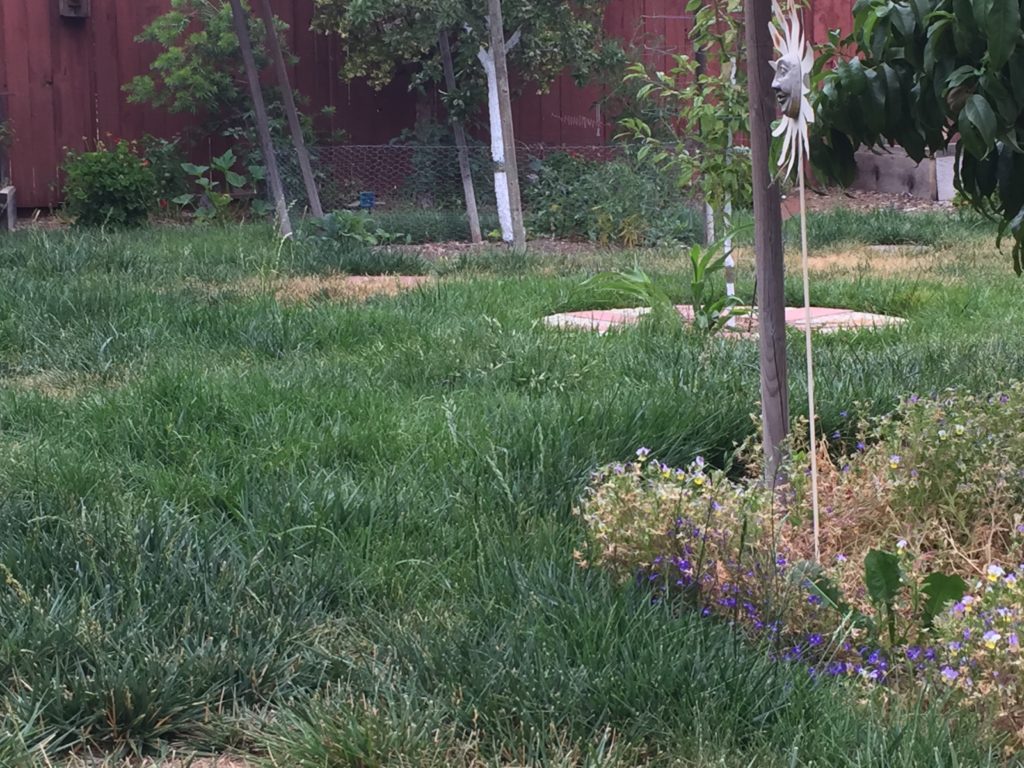“Urban meadows may not require watering, fertilizing, mowing, or edging, but you do need to be vigilant about invasive plants, unwanted weeds, such as foxtails, and diseases.”
![]()

Photo courtesy Kate Russell
A meadow can look and feel better than a lawn, plus there’s a lot less maintenance involved.
By Kate Russell

Kate Russell
Living in Morgan Hill, the first, most obvious reason for shifting a lawn to anything else is water conservation. But there are other good reasons for choosing a meadow over a lawn.
Lawns need lot of water and attention: edging, irrigating, mowing, aerating, acidifying, weeding, and feeding. The job is never done. By mid-summer, most Morgan Hill lawns are burned to a crisp. A meadow might be just what your yard needs.
Meadows are open habitats that feature a variety of grasses, herbs, and other non-woody plants. There can be occasional trees or shrubs, but the main idea is an open field. Meadows have several different flowers, seeds, and vegetation occurring at the same time, changing with the seasons. This makes food and habitat available to many amphibians, birds, insects, and reptiles that see lawns as desolate, unforgiving landscapes. It looks nice, too.
There are different kinds of meadows. They can be agricultural, transitional, perpetual, or urban. Agricultural meadows produce hay for livestock. Transitional meadows are short-lived responses to upheaval. Perpetual meadows occur naturally in a variety of environments. Perpetual meadows reach a point of balance, an equilibrium that we can rarely replicate. Which leads us to urban meadows.
 Urban meadows are the ones we create. And they are gaining in popularity as we learn more about the importance of biodiversity and least harm to the environment. As honey bee and monarch butterfly populations decline, many other creatures are also at risk due to habitat loss. Urban meadows allow pockets of natural habitat to co-exist along with our driveways, air-conditioners, and patio furniture.
Urban meadows are the ones we create. And they are gaining in popularity as we learn more about the importance of biodiversity and least harm to the environment. As honey bee and monarch butterfly populations decline, many other creatures are also at risk due to habitat loss. Urban meadows allow pockets of natural habitat to co-exist along with our driveways, air-conditioners, and patio furniture.
Rather than performing all the chores associated with maintaining a lawn, consider allowing your backyard to relax a little. See what grows on its own. Stop mowing and watering. You may be surprised when your backyard ends up looking lusher and greener, without any help from you.
Lawns that traditionally struggle in summer end up getting taller, shading the ground, and stabilizing soil temperatures. They start putting out seeds of their own. Brown patches fill themselves with other herbaceous plants, better suited to your microclimate. Song birds and butterflies become frequent visitors.
 Having a meadow doesn’t mean you’re completely off the yard maintenance hook. Urban meadows may not require watering, fertilizing, mowing, or edging, but you do need to be vigilant about invasive plants, unwanted weeds, such as foxtails, and diseases.
Having a meadow doesn’t mean you’re completely off the yard maintenance hook. Urban meadows may not require watering, fertilizing, mowing, or edging, but you do need to be vigilant about invasive plants, unwanted weeds, such as foxtails, and diseases.
Instead of a labor-intensive lawn, you may find that a meadow offers a softer, richer, more diverse environment that takes less work. You may even want to toss some native flower seeds into the mix, just to see what happens and add a little color. Instead of working your lawn, sit back and enjoy watching your meadow.






